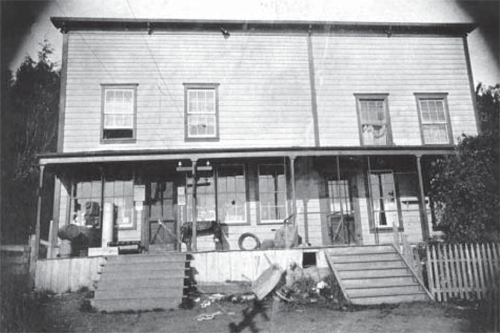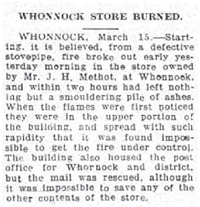
 |
|
| Mr. Methot and the Burning of the Whonnock Store |
||||
 |
The Whonnock
Store was built around 1885 on land purchased by Noble Oliver from Robert
Robertson. After Noble Oliver the owners of the store and the postmasters
were George A. Smith, L.C. York, and Richard Whiting. York’s father
in law, John Williamson, wrote a diary when living in the store in 1897.
The site in now under the Lougheed Highway. Mission Community Archives. |
|||
| An unknown Whonnock store keeper. | ||||
| IT STARTED ALL WITH A PHONE CALL. One day in the summer of 1998 Clair Methot called from Vernon. “My grandfather,” he said, “had a shop in Whonnock.” Did I know about that? I didn’t, but would try to find out. Clair Methot said that he had two letters his grandfather wrote to his daughter, Charlotte, then living in Montreal. The first letter was dated September 1915 and a second one was dated February 1916. Both were written on stationery of the Whonnock Store, his grandfather’s name, J[oseph] H. Methot, printed on the stationery. | ||||
| According to local lore Whonnock’s general store, dating back at least to the 1885, burnt down some time in 1911, when it was owned by Richard C. Whiting. Did Mr. Methot perhaps own a store in Whonnock after this mishap? Why didn’t someone remember him having a store? It was unlikely that he would have managed Graham’s store, built around 1912, and Luno’s shop had yet to be opened, but perhaps he ran a store on that location after Mrs. Sutherland left? (see Whonnock Notes #4, page 24). | ||||
| Who was Joe Methot? | ||||
| What about Joe Methot himself? Clair Methot’s grandfather was born around 1866 in St. Zotique, just south of Montreal, son of a family of farmers. He married Kathleen Spencer and their first child, Charlotte Methot, was born in Owen Sound. The young family came west, where Joe Methot was customs officer at Myncaster, a few miles south of Greenwood. Myncaster and its better-known neighbour Phoenix have long since disappeared. The Methot's second child, a son, Ernest Spencer Methot, Clair’s father, was born in Greenwood around 1902. Ernest was only ten years old when his mother died in 1912. Not too long after his wife’s death, Joe Methot left the Greenwood area, perhaps for New Westminster, before moving the Whonnock. His son, Ernest, was with him in Whonnock. Joe returned to New Westminster, where he died in 1931. He worked as warehouseman for Canadian Pacific Railways for some time. | ||||
| The children, Charlotte and Ernest Spencer were educated in Montreal, where Joe had two or three sisters. Ernest went on to McGill where he received his 4th Degree Steam Engineering papers. Both Charlotte and Ernest returned to British Columbia. Charlotte worked in Vancouver for many years as a secretary-receptionist for a real-estate firm. Ernest lived and worked in the Maple Ridge. That is the information received from Clair Methot. | ||||
| Confirmation of Joe Methot's stay. | ||||
| It was not easy to confirm even Joe Methot’s stay in Whonnock. Joe Methot did not own land in Whonnock and the directories of the years of the First World War generally ignore Whonnock. There wasn’t a break in the postmastership of Richard Whiting either. | ||||
| However, there was some evidence that Mr. Methot had a shop in Whonnock. In the minutes of the Norwegian Lutheran Women’s Association is an entry for 5 June 1915 reading that: “Mrs. A[xel] B. Lee was elected to spend some money from the cash box and buy fabric at Methot’s.” (WHONNOCK NOTES No. 3, page 33). In the minutes of the Ladies Club, to be renamed a few years later to Whonnock Memorial Hall, Mr. Methot was also mentioned. | ||||
|
||||
|
||||
|
||||
| The minutes of the Ladies Club of 5 April 1916 also mentioned a “new postoffice” where they would hang the Roll of Honour of those serving in the C.E.F. for a month, “in order to encourage recruiting.” Apparently the Whonnock post office, which had been in the old Whonnock store since 1885 had moved to its new location shortly before April 1916. Could it be that the old store burned in 1916 and not in 1911 as assumed previously? | ||||
| A hint that Joe Methot could have owned the Whonnock Store when it burned down came from conversation in 1971 or 1972 between Daphne Sleigh and Vera Rolley, the daughter of F.W. Showler of the later general store, next to the present post office. Vera Rolley is quoted by Daphne Sleigh as saying: “The old general store burned down when “Metisse” [Methot] had it.” That was intriguing news, but Clair Methot did not hear his father mention a fire and he could not confirm that this was what happened. | ||||
| Methot's Letters | ||||
| In the absence of a Maple Ridge newspaper, the Fraser Valley Record seemed a likely place where an incident of this kind would have been reported, but the burning of the store was not mentioned at all. | ||||
| Still, if Joe Methot was indeed operating the Whonnock Store in 1915 and 1916 as the two surviving letters suggest the building could not have burned as early as 1911 as believed by the old-timers. | ||||
| Thanks to Clair Methot the two surviving letters addressed to his aunt in Montreal are now a part of the Whonnock Community Association’s collection of historical records. The letters say about life in Whonnock: | ||||
|
||||
|
||||
| Cold winters | ||||
| I searched The British Columbian — the weekly edition version is now available on microfilm at the Maple Ridge Public Library — for information about the weather. Unusually severe winter weather did indeed prevail. More than 29 inches of snow had fallen in January and the average temperature for January was 240, well below freezing and some 10 degrees below the average mean temperature recorded over the previous thirty years. The British Columbian reported on 8 February 1861 that a strong southeast wind was blowing snow off the roofs in New Westminster, adding to the traffic problems on the streets. During the first days of February Victoria’s vehicular traffic came to a standstill due to the steady snowfall. Supplies could not reach the stores and many were closed because the employees could not come to work. | ||||
| Judge Howay reminded the readers that even worse winters were reported in the past. In 1862 ice appeared on the river on 1 January and the Fraser was completely frozen in a matter of slightly more than a week. Harrison Lake and other lakes were frozen at the end of January. The ice was more than a foot thick at Sapperton on 12 February. “Sleighs were running from Langley to several miles below New Westminster.” Some persons walked to New Westminster from Hope over the frozen river. | ||||
| In 1916 the weather was not as severe as in the early 1860s. On 15 February, The British Columbian reported improvements in the weather and predicted an end to the unusual “Eastern winter.” Joe Methot must have breathed a sigh of relief when normal seasonal weather returned to the Lower Mainland. Then, there it was all at once in The British Columbian of 21 March 1916: |  |
|||
| Keeping the fires up to avoid the freezing of the merchandise in the store may have damaged the pipes. Did the sale of the stove to the Ladies Club have anything to do with it? We don’t know. What we know with certainty is that Joe Methot and not Richard Whiting was in charge of the store when it burned. A sale of the property is not reflected in the Municipal records. Methot had perhaps not even been a year in Whonnock when the accident happened. | ||||
| The Whonnock Store burned down in the early morning hours of 14 March 1916 and a few weeks later the new post office was in operation. We know now the reason why in 1916 a new post office at its present location replaced the one in the store, where it had been for some 30 years. | ||||
| A local census held by the Municipality of Maple Ridge and completed in 1916 does not show the Methots any more. Joseph H. Methot and his young son, Ernest, probably left Whonnock shortly after the incident. Did they take their little dog with them? Certainly they were accompanied by some bitter memories. Although it was clear that it was an accident it must have been a traumatic experience for both. They never spoke about it to their family. |
|
|||
| This case shows that reconstruction of local history is only possible by some luck and a large amount of diligent searching for pieces of a jigsaw puzzle. Without Clair Methot’s phone call back in 1998 we would not have known that his grandfather ever lived in Whonnock. It seems that Vera Rolley (née Showler) was the only one remembering that Joe Methot had the store when it burned. If Daphne Sleigh had not recorded that information it would have been lost. Clair Methot’s presence was confirmed by the minute books of the Norwegian Lutheran Women’s Association and the minutes of the women who owned and operated the Ladies Hall. The books were lovingly preserved by individuals who assured that they were placed in safe hands. The letters preserved by the Methots confirmed that Methot owned the Whonnock Store and made us doubt the year of 1911 as the date the store burned. Fortunately the event was recorded in The British Columbian, providing closure to this quest. | ||||
| I am glad I found an answer to Clair Methot’s question about his grandfather who owned a store in Whonnock. | ||||
Fred Braches |
||||